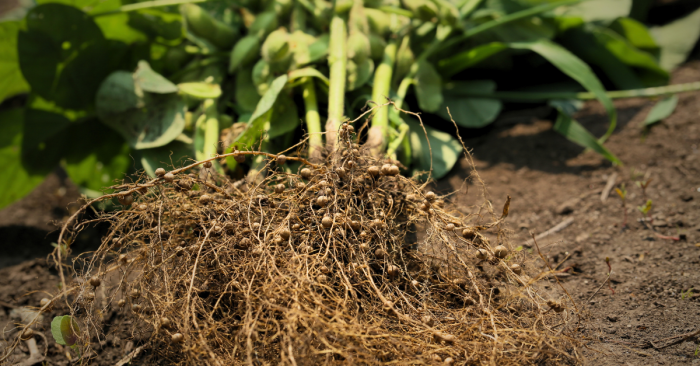Nitrogen: A Most Wanted Nutrient
Nitrogen is the nutrient that keeps farmers up at night. It’s the most commonly deficient nutrient in soils, and the most commonly supplied by fertiliser. Without nitrogen, plants cannot build proteins or produce chlorophyll, which is essential for growth and energy production. Yet right above our heads is an endless supply: 78% of the Earth’s atmosphere is nitrogen gas. The catch? Plants can’t access it directly. Unlocking this nitrogen and keeping it in the soil depends heavily on the soil microbial community.
How Plants Access Nitrogen
Nitrogen Fixation Collaboration

Soybean root nodules
Root nodules are specialised structures that house nitrogen-fixing bacteria. They provide these bacteria with a low-oxygen environment that is ideal for their activity. This environment is perfect for nitrogenase, the enzyme that converts atmospheric nitrogen into ammonium.
Unlocking Organic Nitrogen
Unfortunately, most crops don’t have the luxury of nitrogen-fixing partnerships. For them, organic matter becomes the main source of nitrogen. Organic matter in the soil is made up of plant and animal residues. Microorganisms break it down and convert organic nitrogen into ammonium through a process called mineralisation. Ammonium can then be taken up by plants or further transformed into nitrate through nitrification. It’s a dynamic system where microbes do the heavy lifting, and plants reap the benefits. But plants don’t just wait passively. They attract microbes by releasing root exudates – sugars, amino acids, and signalling compounds that create a hospitable environment around their roots.
To stretch their reach even further, plants also team up with mycorrhizal fungi. These fungi spread their hyphal networks, which transport nutrients, including nitrogen, from decomposing matter. In exchange, they receive sugars, creating a nutrient sharing system that improves soil fertility.
Plant and Microbes Compete for Nitrogen (and Why That's Good)
Plants and soil microbes often compete for nitrogen, especially when the supply in the soil is limited. Bacteria, with their rapid growth, are remarkably efficient at absorbing and storing nitrogen by immobilising it in their cells. This temporarily keeps nitrogen out of the reach of plants. While this may seem unfair, it’s actually a brilliant system. When these microbes eventually die and decompose, they release their stored nitrogen back into the soil in plant-friendly forms such as ammonium and nitrate. This gradual release acts as a natural slow-release fertiliser, ensuring that plants have a steady supply of nitrogen over time.
Keeping Nitrogen in The Soil
To see how these processes work in harmony and the roles regenerative agriculture plays in improving nitrogen retention, check out this video by Jimi Sol on nitrogen cycling in the soil.
Building Resilient Soil Ecosystems
An active and diverse microbial community ensures steady nitrogen availability, improving soil health, organic matter buildup, and nutrient efficiency. Rather than relying on excessive fertilisation, farmers can promote nitrogen fixation and retention through sustainable practices such as adding organic matter (compost, composted manure), using diverse cover crops, enhancing microbial activity and balanced plant nutrition.
Take The Next Step to Healthy Soils
After all, in the world of soil microbes, teamwork really does make the dream work – and BIOTREX analysis is here to reveal the dynamics at play. Whether you’re advancing innovative solutions or promoting resilient agricultural systems, BIOTREX equips you with the insights needed to uncover the role of microbial community in building healthier soils and ecosystems.
Ready to explore how BIOTREX can support your goals?
Book a free call with our experts and discover the impact microbial data can have on your business.

